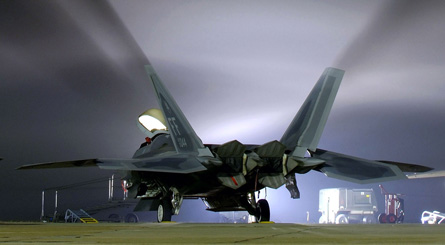The rising sophistication of new-generation fighter aircraft is changing the rules for pilot selection and training. How will air forces keep up with technology?
What makes a good pilot? This question has faced every air force since the widespread adoption of manned, heavier-than-air flight from early in the last century, and the answer today remains as difficult to pinpoint as ever. As new combat aircraft such as the Eurofighter Typhoon and Lockheed Martin F-22A Raptor leave their lengthy development phases and begin to enter frontline use, operators are faced with a major challenge: how to prepare their new pilots to operate these technologically charged machines.
|
|---|
Single-seat types like the F-22 demand a new training concept |
In an age of quadruplex digital fly-by-wire control, carefree handling, onboard diagnostics and advanced electronically scanned array (AESA) radar, which skills must a pilot possess to harness the massive information potential of the aircraft system at his/her control?
Air forces around the world are facing a crisis, as the way they train students has in many cases barely changed in the last 50 years and their current training aircraft fleets offer little or no systems commonality with the aircraft assigned to warfighting units. The rapid spread of the network-centric warfare concept within the last few years has also brought an increasing need for pilots to become information managers, requiring them to spend less time and effort in operating their aircraft, which are becoming comparatively easier to fly.
Much as the phrase "the CNN effect" has found its way into popular culture, it is rare to speak to officials involved in the training sector without them mentioning "the Nintendo generation". Old pilots can be severely challenged by the demands of using multifunction touch-screen displays, helmet-mounted sights and hands on throttle and stick controls, they say, but young students with years of experience playing on games consoles rarely encounter such difficulties.
"Fifteen years ago we were looking for stable extroverts," notes a former UK Royal Air Force navigator and qualified flying instructor who now works in the training industry. "Maybe now we need geeks." In an example of the differing skills required to fly the UK Royal Air Force's eventually swing-role Typhoon, the service has successfully converted an initial group of four former Panavia Tornado F3 navigators to fly and instruct on the type.
While developed nations are reducing the size of their armed forces and the number of fighter aircraft assigned to the frontline, militaries continue to demand fresh throughput of aircrew to support their rotary, air transport and fast jet communities. But rather than have such students cut their teeth by performing map and stopwatch navigation tasks in obsolete aircraft with analogue cockpit displays, they are now looking to embrace technology at the earliest stage possible.
Referred to as "downloading", this process will provide the skills required to fly a new fighter into combat earlier than was previously possible, exponents say. It will also reduce costs at the operational conversion unit level and blur the boundaries between the various current phases of pilot training, testing student capabilities at an early stage of the training process.
"There are new skill requirements that call for a redesign of existing training systems," says retired Italian air force Gen Vitantonio Di Lorenzo, now a representative for Alenia Aermacchi. Key attributes for modern training aircraft should include a high thrust-to-weight ratio, an angle of attack performance of greater than 30° and low life-cycle costs, he claims, extolling the maxim to "train like you fight".
With frontline fighters to use systems such as AESA radars and beyond-visual-range air-to-air missiles, the training sector needs to keep up by providing embedded simulation capabilities which can remove some training cost and airframe wear and tear from the frontline squadron or operational conversion unit. This process will be of particular importance as air forces increasingly field single-seat fighters such as the Typhoon and Lockheed F-35 Joint Strike Fighter. Another aspect of this development will be the increased use of networked simulators to practise composite air operations with multiple aircraft types from individual or partner air forces.
The main onus for such skill development work will fall on the advanced jet and lead-in fighter trainer sector, for years dominated by the BAE Systems Hawk. However, the UK company is now facing stiff opposition from designs such as the Alenia Aermacchi M-346 and Korea Aerospace Industries/Lockheed T-50, with their manufacturers claiming that such high-energy trainers offer a more realistic training experience. The use of open system architecture design techniques will meanwhile allow trainer aircraft to keep in touch with frontline technology through phased software upgrades.
With most users unconvinced on the benefits of conducting supersonic training, the high-energy argument is still raging. However, in a possible sign of the future, the US Air Force will from later this year prepare its new pilots for operations with the F-22 by placing them in the cockpit of retired Lockheed F-16 fighters, rather than Northrop T-38C Talon trainers.
Source: Flight International
























